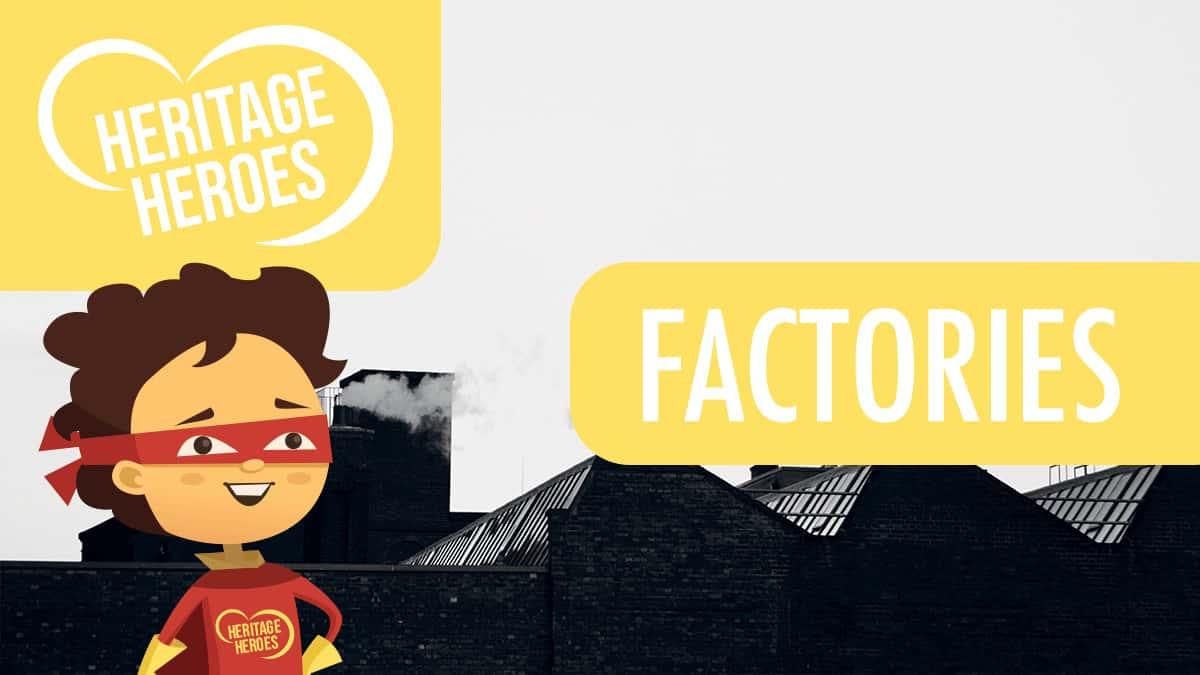Wherever you live, there’s treasure to be discovered!
Not just gold and gems, but stories of buildings, locations and people.
Our heritage is a great wealth… and it’s all around us. Sometimes standing proud in the open air – sometimes hidden behind some bushes.
And to help find it, we’re looking for Heritage Heroes – could you be one?
You can find clues in all sorts of places to find out what happened in your street, neighbourhood and further afield, from famous visitors to historic events.

HERITAGE HEROES. AN INSPIRING AUDIO PRODUCTION FOR FUN KIDS. MADE POSSIBLE WITH THE NATIONAL LOTTERY HERITAGE FUND, WITH THANKS TO NATIONAL LOTTERY PLAYERS.
Mines
If you go back far enough in time, in almost every part of the country, most people lived off the land, growing crops and tending to animals, or providing services like blacksmiths, wheat millers and weavers, or making leather goods and handicrafts.
But with the Industrial Revolution, heavy industry was born – new large coal mines were created, enormous iron and steel works were built, and factories sprung up everywhere, with many people leaving the countryside for a better life.
Whilst Wales, the North and Midlands are renown for their coalfields, Central Scotland and Kent were also important coal producing areas.
Most coal mines have been cleared away, but you can still visit some old mines like Big Pit in South Wales which was a working coal mine between 1880 and 1980, National Coal Mining Museum at Caphouse Colliery in Yorkshire, where mining has been carried out for centuries, National Mining Museum Scotland within the Lady Victoria Colliery, one of the finest examples of Victorian architecture and the last remaining colliery in Scotland
Mills
The climate and abundance of water made the North West an ideal place for cotton mills, with Manchester having 108 at its peak.
Associated with these mills were banks to serve the needs of the mill owners and cotton traders, and warehouses for storage and packing. Often grand buildings, 6 stories high, today they contain offices or apartments for people to live in.
Why not visit… New Lanark is a unique 18th century Mill Village sitting alongside the picturesque River Clyde. The Textiles Gallery at Manchester’s Science and Industry Museum tells the story of the people, places and products that made cotton. Dubbed ‘Cottonopolis’, Manchester was once the international centre of the world’s cotton industry. The city imported up to a billion tonnes of raw cotton a year, towns like Bolton and Preston became manufacturing centres and Oldham’s Platt Brothers & Co. Ltd. built textile machines for mills across the world.
Factories
Factories are all over the country – they’re buildings where workers use machines to make things – and often at very BIG scale and very quickly – from TVs to toys, as well as food to clothes.
Staffordshire is an area abundant in clay which led it to become the biggest source of ceramic goods in Britain, famous for its tableware, tiles and sanitary ware. Stoke-on-Trent’s skyline was once dominated by thousands of smoky bottle kilns used for firing pottery. Whilst most kilns have gone, 47 are preserved as listed buildings.
Reading was home to world famous Huntley & Palmer biscuit factory, which was so large it had its own railway! Huntley & Palmers started life in 1822 as a small bakery on London Street, Reading. In 1846, it opened a large factory on Kings Road and by 1900 was the largest biscuit manufacturer in the world – employing over 5,000 people! Whilst the factory has gone, the old recreation club remains, along with its Huntley & Palmers sign.
Harrow is famous for its school – but was also once home to Kodak and the world famous Whitefriars glassworks. Originally located in central London, the glassworks moved to Harrow in 1923 because of the railway linking London with the Midlands and Scotland, bringing in raw materials and taking away finished glassware.
Over the last hundred years, whilst the nature of industry has changed, large factories continued to be built – like car factories such as British Leyland at Longbridge, Ford in Dagenham and Vauxhall in Luton – all large employers.
An easy way to find out the industrial past of your area is to visit a specialised museum – like Ironbridge, Black Country Living Museum, Swansea Waterfront Museum, Bradford’s Industrial Museum, New Lanark in Scotland or Lion Salt Works in Marsdon – amongst many others.
Have a go at drawing the buildings you find…
What colours are they?
Do they have lots of windows or just a few?
Are there any symbols you could use to explain where they are? Why not create some of your own?
Don’t forget to colour them in!
Look for Quarters!
But don’t do things by halves – look for Quarters!
Certain trades often existed in areas known as a Quarter, for example the Jewellery Quarter in Birmingham which has been home to jewellery makers and precious stones traders for hundreds of years.

Now it’s over to you! Here’s a reminder of things to look for to help you find out about the place where you live.
1 – Go online or visit your local library or specialist industrial museum to get the lowdown on what industries gave employment to people where you live.
2 – See if you can talk to an older person in your area to see what industries they and their families worked in and how they changed over time.
3 – And have look for old warehouses and office buildings. They might still exist but just do a different role today. You might also spot clues to old factories and industries through street names or the names of areas where you live. As well as old recreation club buildings that might still exist.
Here are some helpful links that will help you become a Heritage Hero!
Look at some old maps: www.townmaps.history.ac.uk/
Explore what rural life was like: www.merl.reading.ac.uk
Agriculture Archives: www.nationalarchives.gov.uk/help-with-your-research/research-guides/agricultural-statistics-england-wales
Industrial History: www.museums.co.uk/museum-type/industrial/









